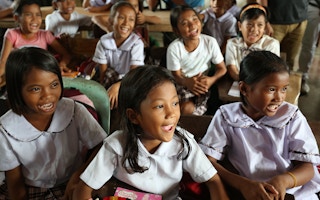Children must be at the centre of climate actions in the East Asia and Pacific region where they face multiple climate-related shocks and hazards, from floods and water contamination to air pollution and disease, UNICEF urges.
According to a report by the UN children’s agency, 460 million children in the region are exposed to air pollution, 140 million to water scarcity, and 120 million to coastal flooding. One billion children are living in countries considered at high risk for climate change impacts.
‘Over the Tipping Point’ warns that “polycrisis”, or multiple and overlapping shocks and hazards, is taking a toll on the coping strategies of children and exacerbating inequality.
The UNICEF report, released May, says that such shocks are faced by more than 40 per cent of children in the region against the global average of 14 per cent.
“Due to their physiology, climate change will increase children’s risks to water and heat stress, food insecurity, rising air pollution, increased risk of vector-borne diseases, acute respiratory infections, diarrheal diseases and malnutrition,” Luis Rodriguez, climate and resilience lead of the International Federation of Red Cross and Red Crescent Societies Asia Pacific, tells SciDev.Net.
“
There is an urgent need to build the resilience of children, prepare and prioritise them to foster their climate adaptation in anticipation of frequent and severe climate hazards.
Luis Rodriguez, climate and resilience lead, International Federation of Red Cross and Red Crescent Societies Asia Pacific
Children born in East Asia and the Pacific are experiencing a six-fold increase in climate-related disasters compared to those born 50 years ago, according to UNICEF. And the frequency and intensity of disasters will continue to rise.
“There is an urgent need to build the resilience of children, prepare and prioritise them to foster their climate adaptation in anticipation of frequent and severe climate hazards,” adds Rodriguez.
“Immediate attention to improved access of children to resilient WASH (water, sanitation and hygiene), health, nutrition, education, social and children protection can reduce their overall climate risk,” he says.
Rodriguez believes climate policies and adaptation plans must be “child-friendly” and ensure the representation of children.
In a 2021 global survey by Plan International, nearly three-quarters of respondents from 37 countries were concerned about climate change but knew little about their countries’ climate policies. Eighty-four per cent believed that their governments’ efforts to include them in climate-related policies were inadequate, while only 22 per cent had been taught climate policies and frameworks.
“Many don’t know about the Paris Agreement or how to get involved in climate processes in their country,” says Lengkong Vanda, head of disaster risk management at Plan International Asia Pacific. “This prevents their voices from being heard.”
“Countries’ strategies on tackling climate change must meet the needs of marginalised groups and include them in political decision-making,” Vanda says.
Including young people will ensure climate actions take into account their rights and give them equal opportunities, including in the transition to a carbon-free economy, she adds.
Vanda also stressed the importance of providing spaces to allow girls and women to “share and elevate their voices”, including protecting them online and in public forums so they can confidently and safely speak about climate change.
Strengthening health systems by including community engagement by young people as well as ensuring the availability of nutritious foods is important, says Silvia Gaya, regional adviser for WASH, climate and sustainable environment at UNICEF East Asia and Pacific.
“Policies should work to guarantee the accessibility of nutritious foods with low environmental impacts for children, adolescents, and women, while also restricting the access to unhealthy foods with negative environmental impacts,” she adds. “Fiscal measures have potential to both subsidise nutritious and sustainable foods to make them affordable, while taxing unhealthy unsustainable foods to show their true environmental and health costs.”
Gaya says the school food environment is an entry point to promote healthy food to children and adolescents.
Meanwhile, Ruben Rodriguez, social policy specialist of UNICEF East Asia and Pacific, says strengthening social protection programs and using a comprehensive approach can be a good strategy to tackle the increasingly complex challenges faced by children.
“Social protection programmes can be enhanced to maximise and sustain important food security and nutrition results, particularly in the face of economic shocks,” Rodriguez tells SciDev.Net.
Rodriguez said: “Covid-19 has also shown that social protection should be a right for all, rather than a privilege for a few.
“Similarly, a strong and well-financed social protection system can enable governments to protect households and livelihoods, especially children, from the worst impacts of shocks and disasters, which are being exacerbated by climate change.”
The UNICEF report says that social protection remains uneven in terms of coverage and funding. It argues that there should be synergy between climate finance and social protection budgeting for children.
It calls for innovative national, regional and global climate finance tools to reduce the risks from mounting climate-related disasters and slower onset impacts through “youth-led solutions”.
This article was originally published on SciDev.Net. Read the original article.

















